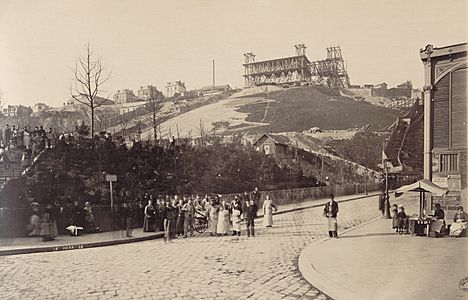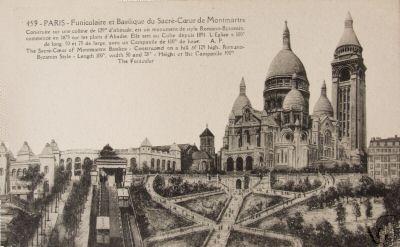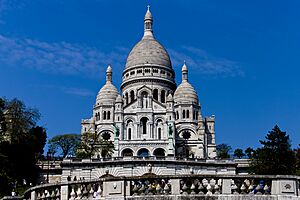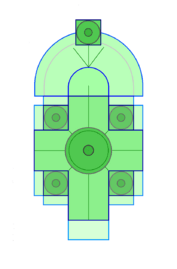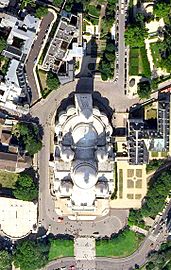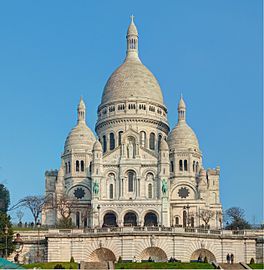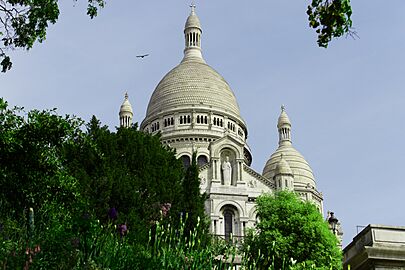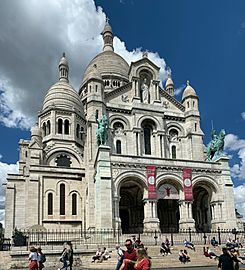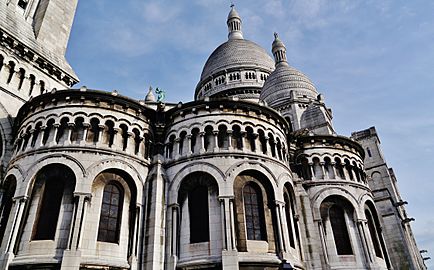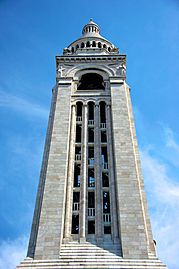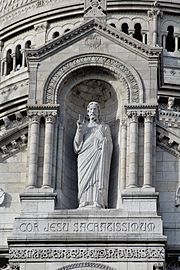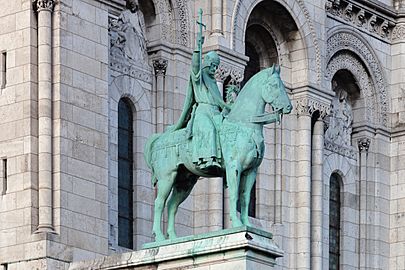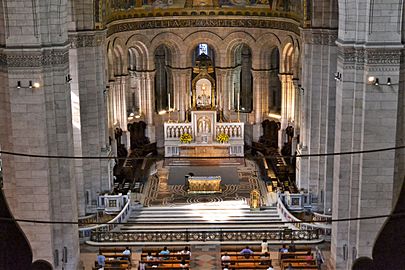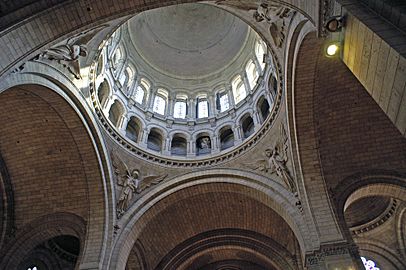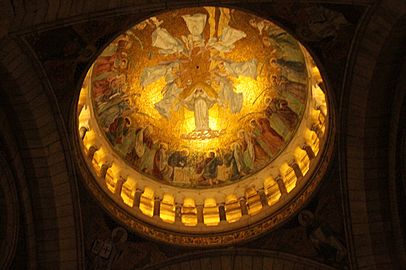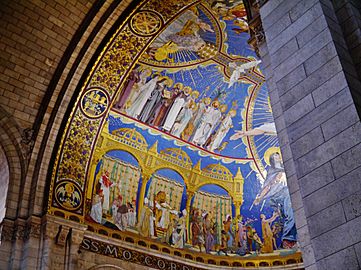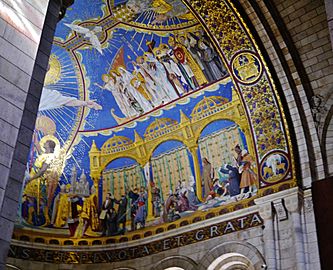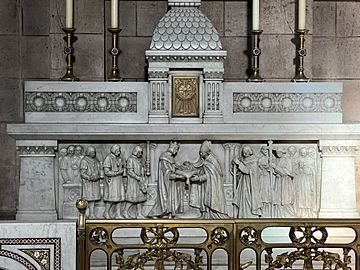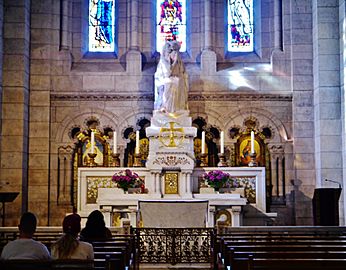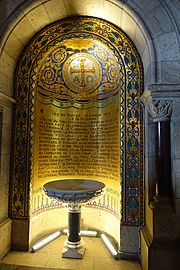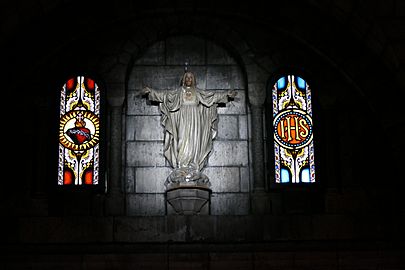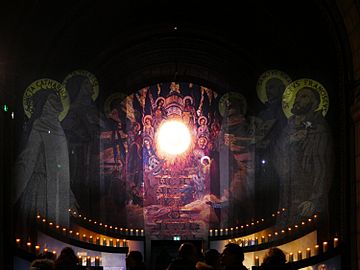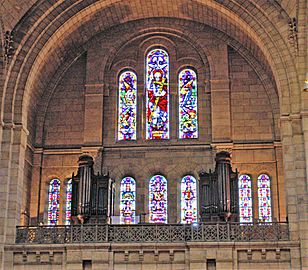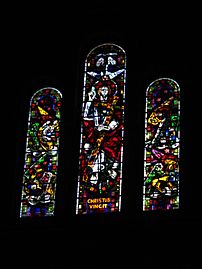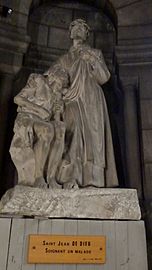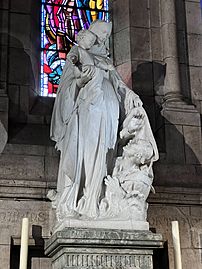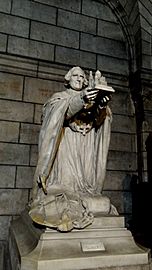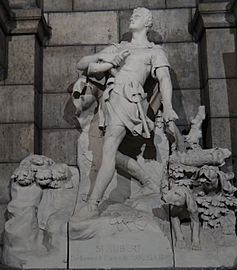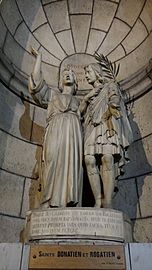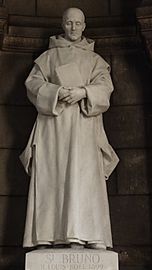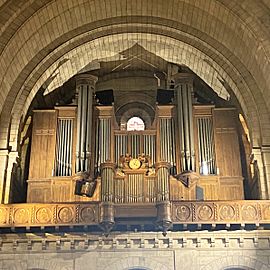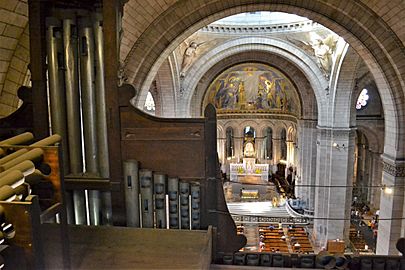Sacré-Cœur, Paris facts for kids
Quick facts for kids Basilica of the Sacred Heart of Montmartre |
|
|---|---|
|
Basilique du Sacré-Cœur de Montmartre
|
|

The Basilica of Sacré-Cœur de Montmartre, as seen from the base of the butte Montmartre. Square Louise-Michel can be seen in the foreground.
|
|
| Location | Paris, France |
| History | |
| Status | Minor basilica |
| Architecture | |
| Architect(s) | Paul Abadie |
| Groundbreaking | 1875 |
| Specifications | |
| Length | 85 metres (279 ft) |
| Width | 35 metres (115 ft) |
| Materials | Travertine stone |
| Administration | |
| Province | Archdiocese of Paris |
The Sacré-Cœur Basilica (say: Sah-kray-Koor) is a famous Catholic church in Paris, France. Its full name is the Basilica of the Sacred Heart of Montmartre. It is dedicated to the Sacred Heart of Jesus. On December 8, 2022, it was officially named a national historic monument.
This beautiful church sits on top of the butte (hill) of Montmartre. From its tall dome, which is 200 meters (about 656 feet) above the Seine River, you can see all of Paris and its surrounding areas. It is the second most visited place in Paris, right after the Eiffel Tower.
The idea for the basilica came from Felix Fournier, a bishop, in 1870. This was after France lost a big battle in the Franco-Prussian War. He believed France's problems were due to a decline in morals. He suggested building a new church in Paris dedicated to the Sacred Heart of Jesus. The church was built on the highest point of the city. Because of its location and the time it was built, some politicians have seen it as a symbol of past conflicts.
The church was designed by Paul Abadie. His design, which mixed old Roman and Byzantine styles, was chosen from many ideas. Building started in 1875 and took 40 years, with five different architects working on it. It was finished in 1914 and officially opened in 1919, after World War I.
Since 1885, the Sacré-Cœur Basilica has had continuous prayer, called perpetual adoration, for the Holy Eucharist. The hill of Montmartre is also famous as the place where Saint Denis of Paris, the patron saint of Paris, was martyred.
Contents
History of the Basilica
Why the Church Was Proposed
The idea for a new church in Paris, dedicated to the Sacred Heart of Jesus, came on September 4, 1870. This was after France's defeat and the capture of Emperor Napoleon III by the Prussians in the Franco-Prussian War. Felix Fournier, the Bishop of Nantes, suggested it. He believed France's loss was a punishment for the country's moral decline since the French Revolution.

In January 1871, a kind person named Alexandre Legentil joined Fournier. Legentil also felt that France had been punished for its mistakes. He promised to help build a church dedicated to the Sacred Heart of Jesus to ask for forgiveness and help for France. His influence helped raise a lot of money for the church, all from private donations.
Choosing the Location
Montmartre was chosen for the new basilica because it is very high and can be seen from many parts of Paris. It was also chosen because of its connection to Saint Denis of Paris. Since the land belonged to both the local government and private owners, the French parliament helped get the site. They said building the basilica was important for the country. In July 1873, the plan was approved. Construction began in 1875.
Montmartre, meaning "Hill of the Martyrs," was also important for early Christianity. People believe that Saint Denis of Paris, the patron saint of Paris, was beheaded there by the Romans. His burial place later became the Basilica of Saint Denis, where French kings were traditionally buried.
Montmartre was also where the Society of Jesus, a large and important religious group, began. In 1534, Ignatius of Loyola and his followers made their vows in Saint-Pierre de Montmartre, one of Paris's oldest churches.
How the Church Was Built
A competition was held to choose the design for the basilica. Seventy-seven different plans were submitted. Paul Abadie was chosen as the architect, and the first stone was laid on June 16, 1875.
Building the church was difficult at first because the ground was not stable. Workers had to dig 83 wells, each 30 meters (about 98 feet) deep. These wells were filled with rock and concrete to create strong pillars under the basilica. The first 7 million francs, all from private donations, were spent before any part of the church could be seen above ground. A temporary chapel was opened in 1876, and visits by pilgrims helped bring in more money.
After the foundation was finished in 1884, Abadie passed away. Five other architects took over and made many changes to the design.
During construction, some people tried to stop the project. In 1882, a group led by Georges Clemenceau won the election. Clemenceau immediately tried to stop the work, and parliament blocked funding. However, stopping the project would have cost 12 million francs in penalties, so the government had to let the building continue.
In 1891, the inside of the basilica was finished and opened for public worship. In 1897, Clemenceau tried again to stop its completion, but his idea was strongly rejected. Canceling the project would have meant paying back 30 million francs to the eight million people who had donated.
The church's dome was finished in 1899, and the bell tower in 1912. The basilica was fully completed in 1914 and officially opened in 1919, after World War I.
Disagreements About the Church
Some journalists and politicians criticized the church. They linked it to the destruction of the Paris Commune, even though the church was planned before the Commune happened. In 1898, Emile Zola wrote that the church was built to make France feel bad for its history of free speech and science.
After the Statue of Liberty was sent from France to the United States, opponents of Sacré-Cœur had a new idea. They suggested putting a full-size copy of the Statue of Liberty right in front of the basilica on Montmartre. This would block the view of the church. However, this idea was too expensive and difficult, so it was dropped.
In 1976, a bomb exploded inside the church.
To show their feelings about the church, in 2004, the socialist mayor of Paris, Bertrand Delanoë, and the mayor of the 18th district, Daniel Vaillant, renamed the square in front of the church. They named it after Louise Michel, a famous anarchist who took part in the Paris Commune.
Lionel Jospin, who was Prime Minister from 1997 to 2002, also said he wished the basilica would be torn down. He called it a symbol of "bad taste."
In 2021, some politicians tried to stop the church from being declared a national historic monument. They wanted to avoid celebrating the church's history in the same year as the 150th anniversary of the Paris Commune. So, the decision was postponed until 2022.
The church was finally named a national historic monument by a unanimous vote on December 8, 2022. This decision was immediately criticized by politician Jean-Luc Mélenchon.
What the Church Looks Like
The church is 85 meters (about 279 feet) long and 35 meters (about 115 feet) wide. It has a large central dome, with a smaller main area (nave), two side sections (transepts), and a front choir area, forming a cross shape. The entrance has three arches, similar to the Périgueux Cathedral. The most striking part is the huge, oval-shaped dome, which is 83.33 meters (about 273 feet) high. It is surrounded by four smaller domes. At the north end is the bell tower, 84 meters (about 276 feet) high, which holds the "Savoyarde," the largest bell in France.
The church's style is a mix of Roman and Byzantine designs. This was an unusual style at the time. It was partly a reaction against the more ornate style of buildings like the Palais Garnier opera house. Several architects worked on the church over the years, adding different elements to its design.
Some parts of the design, like the tall domes and the shapes of the windows on the south side, have a Neo-classical look. These were added by later architects.
Outside the Church
The bell tower on the north side holds the 19-ton Savoyarde bell. This is one of the heaviest bells in the world and was made in 1895. Its name refers to the region of Savoy joining France in 1860.
The main entrance on the south side is decorated with sculptures that combine religious and French national themes. It has a statue of the Sacred Heart of Christ at the top. The arches are decorated with two statues of French saints on horseback: Joan of Arc (from 1927) and King Saint Louis IX. Both are made of bronze.
-
Saint Louis (Louis IX) (south side)
The white stone of Sacré-Cœur is a type of travertine limestone called Chateau-Landon. This stone is very hard and becomes even whiter when it touches rainwater, making the church look exceptionally bright.
Inside the Church
The main area (nave) is dominated by the very high dome, which represents heaven. It rests on a rectangular space, which represents the earthly world. Large columns connect these two parts, symbolizing the journey between worlds.
The inside of the church is shaped like a Greek cross, with the altar in the middle, similar to old Byzantine churches. The light inside is usually dim because the windows are high above the altar. This creates a special, mystical feeling. Other Byzantine features include the patterns on the tile floor and the glasswork.
The Triumph of the Sacred Heart of Jesus Mosaic
The mosaic above the choir is called The Triumph of the Sacred Heart of Jesus. It is the largest and most important artwork in the church. It was made by Luc-Olivier Merson, H. M. Magne, and R. Martin, and was finished in 1923. The mosaic is made of 25,000 pieces of colored and gold-covered ceramic. It covers 475 square meters (about 5,113 square feet), making it one of the biggest mosaics in the world.
In the center of the mosaic is Jesus Christ, dressed in white, with open arms showing his heart. Next to him are his mother, the Virgin Mary, and the Archangel Michael, who protects the church and France. At Jesus's feet, Joan of Arc kneels and offers him a crown. A figure of Pope Leo XIII offers a globe, symbolizing the world.
To the right of Christ, a scene shows "The Homage of France to the Sacred Heart." Here, popes and cardinals present a model of the basilica to Christ. To his left is "The Homage of the Catholic Church to the Sacred Heart." This shows people from different continents honoring the Sacred Heart. At the bottom of the mosaic, a Latin message says the basilica is a gift from France: "To the Sacred Heart of Jesus, France fervent, penitent and grateful." The word "grateful" was added after World War I.
At the top of the mosaic, there is another procession of "Saints of France and Saints of the Universal Church." In the entire mosaic, the artists used elements of Byzantine art in how they arranged the figures, the way they showed depth, and their use of many colors with silver and gold.
The church complex also has a garden for quiet thought, with a fountain. You can go to the top of the dome for a spectacular view of Paris, which spreads out to the south of the basilica.
Remember, cameras and video recorders are not allowed inside the basilica.
Chapels
The inside of the basilica is surrounded by many chapels. Most of these were given by different professional groups or religious orders. The chapels are decorated with sculptures, carvings, and tapestries, often related to the jobs of the people who donated them. For example, the Chapel of the Order of Notre Dame of the Sea has tapestries showing Christ walking on water. Starting from the right of the main entrance, some of these chapels include:
- The Chapel of the Archangel Michael (for armies)
- The Chapel of Saint Louis (Louis IX) (for attorneys)
- The Tribune of Commerce and Industry
- The Chapel of Marguerite-Marie Alacoque
- The Chapel of Notre Dame of the Sea
The main altar area is also surrounded by seven more chapels:
- The Chapel of Saint Francis of Assisi
- The Chapel of Saint John the Baptist (given by Canada and the Knights of Malta)
- The Chapel of Saint Joseph
- The Chapel of the Virgin Mary
- The Chapel of Saint Luke the Evangelist, Comé and Damien (for doctors)
- The Chapel of Ignace de Loyola
- The Chapel of Saint Ursula of Cologne
- The Chapel of Saint Vincent de Paul
- The Tribune of Agriculture
- The Chapel of the Queens of France
Crypt
The crypt below Sacré-Cœur is different from most crypts, which are usually completely underground. At Sacré-Cœur, the crypt has stained glass windows. This is because there is a trench around it that lets light in. In the center of the crypt is the chapel of the Pieta. Its main feature is a large statue of the Virgin Mary at the foot of the cross, made by Jules Coutain in 1895. There are also 14 other chapels in the crypt, matching the ones on the level above. The crypt holds the tombs of important people who helped build the basilica.
Art and Decorations
The walls, floor, and architecture of the church are covered in decorations. Much of this art is in a neo-Byzantine style, with detailed patterns and many colors.
Stained Glass
Sculpture
The Grand Organ
The basilica has a very large and beautiful pipe organ. It was built by Aristide Cavaillé-Coll, who was the most famous organ builder in Paris in the 1800s. He also built organs for other famous churches like Saint-Denis Basilica and Notre Dame de Paris. This organ has 109 rows of pipes and 78 stops. It was very advanced for its time.
The organ was originally built in 1898 for a castle in Biarritz. It was the last instrument Cavaillé-Coll ever built. In 1905, it was moved to Paris.
The organ was recognized as a national landmark in 1981. It has been repaired several times. Both the organ and the church itself are considered national landmarks.
The Bells
The bell tower of the Sacré-Cœur Basilica holds five bells. The four smaller bells are named Félicité, Louise, Nicole, and Elisabeth. These bells were moved to the basilica in 1969.
Below these four bells is a huge bell called "The Savoyarde." It is the biggest bell in France. Its full name is “Françoise Marguerite of the Sacred Heart of Jesus." It was made on May 13, 1891, in Annecy-le-Vieux.
The Savoyarde bell only rings for major religious holidays like Easter, Christmas, and others. One special time it rang was on the night of August 24, 1944. This was when French troops entered Paris during the Liberation of Paris from Nazi German occupation. The bell rang when the news was broadcast, and priests were asked to ring their church bells. The Savoyarde can be heard from 10 kilometers (about 6 miles) away!
This bell is the fifth largest in Europe. It weighs 18,835 kilograms (about 41,524 pounds). It was given by four regions of Savoy. It was brought to the basilica on October 16, 1895, pulled by 28 horses. In the late 1990s, a crack was found in the bell.
Role in Catholicism
The church is dedicated to the Sacred Heart of Jesus. This devotion became very popular after the visions of Saint Margaret Mary Alacoque in the 1600s. The basilica was officially opened on October 16, 1919.
Since 1885 (even before it was fully built), the Blessed Sacrament (Christ's body, used in Mass) has been continuously displayed above the main altar. This continuous prayer, called perpetual adoration, has happened without interruption since 1885.
Visitors are asked to dress respectfully when visiting the basilica and to be as quiet as possible. This is to avoid disturbing people who have come from all over the world to pray. Taking photos inside the basilica is not allowed.
How to Get There
You can reach the basilica by bus or by metro line 2 at the Anvers station. Sacré-Cœur is open every day from 6:00 AM to 10:30 PM. You can visit the dome from 9:00 AM to 7:00 PM in the summer and until 6:00 PM in the winter.
A Copy in Martinique
A much smaller version of the basilica, called Sacré-Cœur de la Balata, is located north of Fort-de-France, Martinique. It was built for people who lost their homes after the eruption of Mount Pelée and was dedicated in 1915.
See also
 In Spanish: Basílica del Sagrado Corazón (París) para niños
In Spanish: Basílica del Sagrado Corazón (París) para niños
- Architecture of Paris
- List of historic churches in Paris
- List of tourist attractions in Paris
- Saint Margaret Mary Alacoque, who promoted devotion to the Sacred Heart of Jesus
- Blessed Mary of the Divine Heart, who promoted the world consecration to the Sacred Heart of Jesus
- Church of the Sacred Heart of Jesus, a large shrine dedicated to the Sacred Heart of Jesus
- Sanctuary of Christ the King, the Portuguese national shrine of the Sacred Heart of Jesus
- A statue to François-Jean de la Barre was put up in front of Sacré-Cœur as a protest against its construction.
- Valley of the Fallen, a Catholic basilica and memorial in Spain


